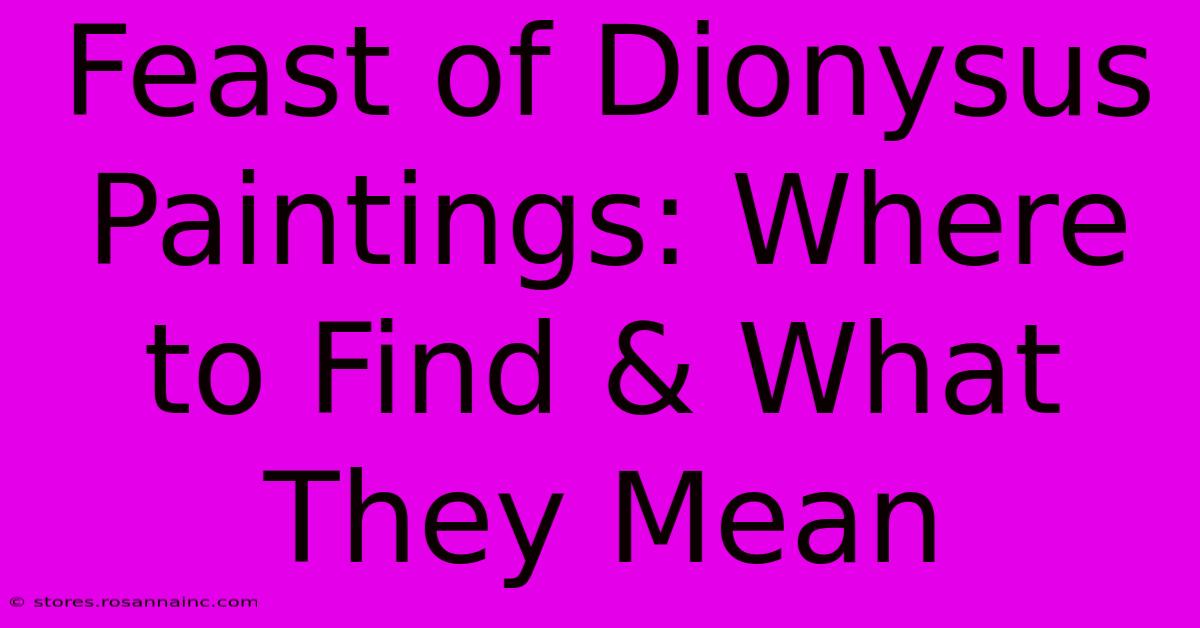Feast Of Dionysus Paintings: Where To Find & What They Mean

Table of Contents
Feast of Dionysus Paintings: Where to Find & What They Mean
The Feast of Dionysus, also known as the Dionysia, was an ancient Greek festival celebrating the god of wine, fertility, and theatre. Depictions of these exuberant celebrations are scattered throughout art history, offering a fascinating glimpse into ancient Greek culture and religious practices. This article explores where to find these captivating paintings and what they symbolize.
Understanding the Dionysian Revelry
Before delving into the locations of these artworks, it's crucial to understand the context. Dionysus, a powerful and often ambivalent deity, presided over both the ecstasy of intoxication and the primal forces of nature. The Dionysian festivals were characterized by wild revelry, including drinking, dancing, music, and theatre. Paintings depicting these feasts often showcase these elements, but also explore the more profound aspects of the god's influence.
Key Symbols in Feast of Dionysus Paintings:
- Dionysus himself: Often depicted as a youthful, handsome god, sometimes with ivy or grapevine wreaths, symbolizing his connection to nature and wine.
- Maenads: Female followers of Dionysus, often shown in a state of ecstatic frenzy, participating in wild dances and rituals. Their wildness represents the untamed forces of nature.
- Satyrs: Male companions of Dionysus, often depicted as half-human, half-animal creatures, representing the uninhibited and sensual aspects of the celebrations.
- Thyrsus: A staff topped with a pine cone, a symbol of Dionysus's power and authority.
- Wine and grapes: Obvious symbols of abundance, fertility, and the intoxicating power of the god.
- Animals: Panthers and other wild creatures were associated with Dionysus, reflecting the untamed energy of his celebrations.
Where to Find Feast of Dionysus Paintings
Unfortunately, due to the perishable nature of many ancient art forms, original paintings directly depicting Dionysian feasts from antiquity are rare. However, we can find their influence and depictions in various places:
1. Museums with Ancient Greek Collections:
Many major museums around the world house artifacts and artwork from ancient Greece. Searching their online catalogs for keywords such as "Dionysus," "Dionysia," "Maenads," "satyr," and "thyrsus" will yield relevant results. Some key museums to explore include:
- The National Archaeological Museum of Athens: Houses a vast collection of Greek antiquities, including pottery, sculptures, and possibly some artwork related to the Dionysian celebrations.
- The Louvre Museum (Paris): Possesses a significant collection of Greek and Roman art.
- The Metropolitan Museum of Art (New York): Also boasts a substantial Greek and Roman art collection.
- The British Museum (London): Holds a vast collection of artifacts from around the world, including many from ancient Greece.
Remember to check the museum websites for their specific collections and online catalogs.
2. Roman Frescoes and Mosaics:
While not strictly Greek, Roman art heavily borrowed from Greek artistic traditions. Roman frescoes and mosaics often depict scenes of bacchanalia (Roman equivalent of the Dionysia), providing further visual representations of these celebrations. You might find these in museum collections focused on Roman art or in situ at archaeological sites in Italy.
3. Later Artistic Interpretations:
Renaissance and later artists have also frequently drawn inspiration from the myths and imagery surrounding Dionysus. Searching for artworks depicting "Bacchanalia" or "The Triumph of Bacchus" (the Roman name for Dionysus) can reveal a rich tapestry of interpretations of these celebrations throughout art history.
The Meaning Behind the Paintings
The meaning of Feast of Dionysus paintings is multifaceted. They are not simply depictions of drunken revelry; instead, they explore a complex interplay of themes:
- Religious devotion: The paintings depict acts of worship and celebration of a powerful deity.
- Celebration of life and fertility: The themes of abundance, intoxication, and uninhibited joy reflect a profound appreciation for the natural world and its cycles.
- Exploration of human nature: The depiction of ecstasy, frenzy, and sensual abandon explore the extremes of human emotion and experience.
- Theatre and performance: The Dionysia included theatrical performances, and many paintings depict scenes that appear to be theatrical in nature.
By examining the details within these paintings – the expressions on the faces of the participants, the dynamic poses, and the carefully chosen symbols – we can gain a richer understanding of the beliefs and practices of ancient Greek culture and the enduring legacy of Dionysus. Discovering and interpreting these artworks allows us to connect with a vibrant and influential part of history.

Thank you for visiting our website wich cover about Feast Of Dionysus Paintings: Where To Find & What They Mean. We hope the information provided has been useful to you. Feel free to contact us if you have any questions or need further assistance. See you next time and dont miss to bookmark.
Featured Posts
-
Bingeworthy Garrett Hedlund Where To Start And What To Skip
Feb 10, 2025
-
Transform Your Perception The Cover Doesnt Tell All
Feb 10, 2025
-
Hurts Eagles Super Bowl Quarterback
Feb 10, 2025
-
Super Bowl Ad Controversy And Failure
Feb 10, 2025
-
January 28 Zodiac What Your Birthdate Says About You
Feb 10, 2025
